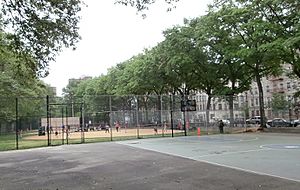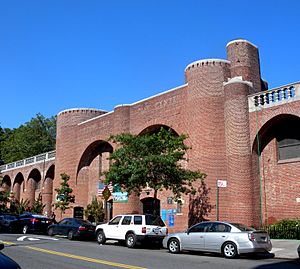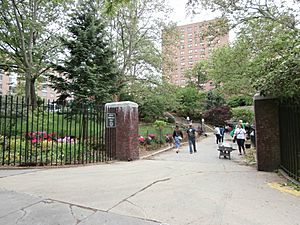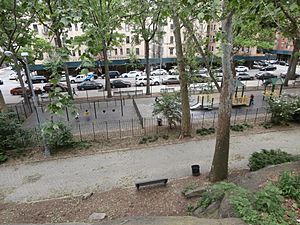Jackie Robinson Park facts for kids
Quick facts for kids Jackie Robinson Park |
|
|---|---|
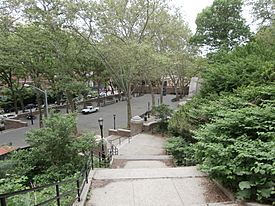
The curved stairway from Edgecombe Avenue and 150th Street, looking down toward the dance terrace
|
|
| Type | Urban park |
| Location | Hamilton Heights and Harlem, Manhattan, New York City |
| Area | 12.77 acres (5.17 ha) |
| Created | 1911 |
| Operated by | NYC Parks |
| Public transit access | Subway: Bus: M2, M3, M10, Bx6, Bx6 SBS, Bx19 |
Jackie Robinson Park is a public park in the Hamilton Heights and Harlem areas of Manhattan, New York City. It used to be called Colonial Park. This park is about 12.77 acres (5.17 ha) in size. It stretches from Bradhurst Avenue on the east to Edgecombe Avenue on the west. To the north, it's bordered by 155th Street, and to the south by 145th Street.
The park has many cool features. You can find baseball fields, basketball courts, and restrooms. There's also a bandshell for performances. These are built into the park's hilly landscape. Inside the park, you'll also find the Jackie Robinson Play Center. This center has a recreation building and a swimming pool. The New York City Department of Parks and Recreation (NYC Parks) takes care of Jackie Robinson Park.
The land for the park was bought between 1894 and 1899. The first part of the park opened in 1911 as Colonial Park. The swimming pool was built in 1935–1936 by Aymar Embury II. This was part of a big project called the Works Progress Administration (WPA). The pool was fixed up a lot from 1978 to 1980. In 1978, the park was renamed after Jackie Robinson, a famous baseball player. In 2007, Jackie Robinson Park became a city landmark.
Contents
What's Inside Jackie Robinson Park?
Jackie Robinson Park is bordered by 145th Street to the south and Edgecombe Avenue to the west. To the north, it meets 155th Street and the 155th Street Viaduct. Bradhurst Avenue is on its east side. The park covers about 12.77 acres (5.17 ha). It's much narrower from west to east than it is from north to south.
The park is built on a steep hill. The Edgecombe Avenue side is much higher than the Bradhurst Avenue side. North of 155th Street, the park's cliff turns into Coogan's Bluff. This is part of Highbridge Park. The old Polo Grounds baseball stadium used to be below this cliff. Most of the park's entrances and facilities are along Bradhurst Avenue. There are also stairs from Edgecombe Avenue at 145th, 150th, and 155th Streets. Because of this, people from Central Harlem (to the east) use the park more than those from Hamilton Heights (to the west).
Jackie Robinson Park is one of four "Historic Harlem Parks." These parks are known for their steep hills. The other parks in this group are St. Nicholas Park, Morningside Park, and Marcus Garvey Park.
Fun Places and Sports Areas
Jackie Robinson Park has two playgrounds near the Bradhurst Avenue side. Both playgrounds have restrooms. The playground at 149th Street is called Playground One Forty Nine CIL. The one between 152nd and 153rd Streets is called Playground One Fifty Two CLII. The 152nd Street playground used to be a wading pool.
There's also a sports area along Bradhurst Avenue between the two playgrounds. This area has two baseball fields at 150th Street. There's one basketball court south of 150th Street. You can also find four handball courts at 151st Street. These sports fields and playgrounds were built in 1936. They were part of the Works Progress Administration (WPA) program. They have been updated since then.
The Jackie Robinson Pool
The Jackie Robinson Pool is at the very south end of the park, just north of 146th Street. The pool area has a main swimming pool. North of it is a smaller water play area. The space around the pool is narrow because of the park's shape and hills. This also made the pool area an unusual shape.
The main pool is about 82 feet (25 m) by 236 feet (72 m). It is about 3.5 feet (1.1 m) deep. This pool can hold many swimmers at once. It's mostly rectangular, but its south end is rounded like a semicircle. The old diving pool to the north was shaped like a pentagon. This old diving pool is now a children's play area with sprinklers. There are bleachers (seats) along the west side of the main pool.
The Recreation Center
The recreation center is built on a slope east of the pool. It's located between 146th and 147th Streets. The front of the building on Bradhurst Avenue has two stories. The back, facing the pool, has one story. This back part is actually the second floor of the building.
The building is made of brick and is mostly rectangular. It has a special design with round shapes and details from Romanesque architecture. It looks like a medieval castle! You can see stone decorations and fancy railings on the roof. This design is more detailed than other pools built in the same 1936 WPA program.
The front of the building has fourteen sections. These sections are separated by round columns. The two middle sections form the main entrance. They have wide arches and small doorways. Above the doorways, you can still see faded letters that say "colonial park" and "play center." The other sections have narrower arches with windows and doors.
The recreation center was meant to be both a bathhouse and an indoor play area. Inside, on the ground floor, there's a glass booth where people used to buy tickets for the pool. The ceiling has pointed Gothic arches. Stairs lead up to the second floor, where the locker rooms for men and women are. There's also a statue of Jackie Robinson on the west wall. This statue was put there in 1981. The rest of the center has an indoor basketball court, a gym, a media lab, and other rooms.
Paths and Other Features
At 147th Street, there's an outdoor concrete bandshell. It's built into the hillside and faces a dance floor terrace to the east. Inside the bandshell, there's a mural of Jackie Robinson. He was the first black professional baseball player in the major leagues. The mural was painted in 2006.
The dance floor terrace is a wide area with hexagonal stone tiles. It goes north to 148th Street. A brick wall with rounded seating areas surrounds the terrace. North of the dance floor is a wide walkway with hexagonal tiles. This walkway goes to the sports fields at 150th Street.
A curved concrete staircase connects the dance floor terrace and the walkway. It goes from 148th Street and Bradhurst Avenue up to Edgecombe Avenue, near 150th Street. Another path goes from 150th Street and Bradhurst Avenue to the same spot. There's also a path from 153rd Street at Bradhurst Avenue to Edgecombe Avenue's intersection with 155th Street. These paths were there before the WPA renovations in 1936. The WPA changed some paths for the sports fields and repaved others. Some paths were later repaved with asphalt.
The park has two restrooms. One is next to the playground at 152nd Street. It's a square brick building with a sloped roof. It has large round columns at each corner. The other restroom is next to the playground at 149th Street. It's a rectangular brick building. This one was built before the WPA renovations. Also, the south edge of the park has a metal fence with brick posts topped with stone.
Park History
The park sits on a high cliff formed by ancient glaciers. In the late 1700s and early 1800s, this area was part of the Samuel Bradhurst estate. In the early 1890s, there were some brick buildings and small homes here.
How the Park Was Created
A law to create Colonial Park and nearby St. Nicholas Park was passed on February 26, 1894. The land for Colonial Park was bought between 1894 and 1899. It cost about $1.5 million. The park was named "Colonial Park" because several battles from the American Revolutionary War happened in this area.
In the early 1900s, New York City turned the land into a park. The northern part, from 150th to 155th Streets, was designed with paths and plants in 1907 and 1908. The southern part, with a playground and restroom, opened to the public on August 12, 1911. The total cost was $2 million.
After the park opened, the area to the west became known as Sugar Hill. This was a popular place for wealthy Black Americans to live during the Harlem Renaissance. Famous people like W. E. B. Du Bois and Thurgood Marshall lived in the Colonial Park Apartments overlooking the park. In its early years, Colonial Park was sometimes used for concerts. Not many changes were made to the park for about twenty years after it opened.
Works Progress Administration Changes
In 1934, Robert Moses became the commissioner of the New York City Department of Parks and Recreation. At this time, the United States was in the Great Depression. Moses started a plan to create jobs for 80,000 people through 1,700 projects.
Moses really wanted to build new swimming pools. He made a list of 23 pools for the city, including one in Harlem. These pools would be built using money from the Works Progress Administration (WPA). The WPA was a government agency created to help people during the Depression. Eleven of these pools were designed at the same time and opened in 1936.
Moses, along with architects Aymar Embury II and Gilmore David Clarke, created a similar design for all 11 pools. Each place would have separate pools for diving, swimming, and wading. They would also have bleachers for watching and bathhouses with locker rooms. The pools had common features like a minimum length of 55 yards (50 m) and underwater lighting. They were built using cheap materials and combined Streamline Moderne and Classical styles. The buildings were also near restrooms, playgrounds, and improved landscapes.
Construction for some of the pools began in October 1934. In mid-1935, Moses announced that Colonial Park would get a recreation center with a pool and sports fields. The Colonial Park Pool was designed with the same equipment as all the other WPA pools.
Construction plans for the bathhouse were filed in October 1935. A temporary bandshell was built that same year. The first improvement finished at Colonial Park was the playground at 152nd Street, which opened in April 1936. By mid-1936, ten of the eleven WPA pools were ready. The Colonial Park Pool was the tenth to open, even though its bathhouse was not fully finished. The pool opened on August 8, 1936. Over 25,000 people attended the opening ceremony. More ballfields and courts opened in October 1936. The bandshell and dance terrace opened in July 1937, followed by the playground at 149th Street that October.
Later Changes and Improvements
After the WPA improvements, Colonial Park didn't get many major updates, just regular fixes. The diving pool and wading pool were filled in at some point. By the 1970s, Jackie Robinson Park and other city parks were not in good shape due to financial problems in New York City.
In 1977, NYC Parks started a project to fix up pools in several parks, including Jackie Robinson Park. They set aside about $2.6 million for its restoration. The pool closed for renovation in 1978. In the same year, the park was renamed after Jackie Robinson. The pool reopened in July 1980 after the $2.6 million renovation.
NYC Parks continued to have money problems in the following years. The pools sometimes had a reputation for being unsafe. In 1991, the mayor planned to close all 32 outdoor pools in the city. This decision was changed after a large donation from a real estate developer and other sources. By the early 2000s, crime in city parks had gone down because of better security. Volunteers also started planting greenery in Jackie Robinson Park in the late 1990s. In early 2000, NYC Parks finished a $1.3 million renovation that improved the playgrounds.
In 2007, the New York City Landmarks Preservation Commission made Jackie Robinson Park a landmark. This included the pool and play center. A $2 million renovation of the bandshell was finished in 2009. In 2016, NYC Parks announced more renovations as part of a $40 million program for eight parks. About $4.7 million was given to Jackie Robinson Park. Because the park was a city landmark, special permission was needed for some changes, like replacing fences. The project was completed in 2020. It included improvements to the entrances, paths, lights, and other parts of the park.


